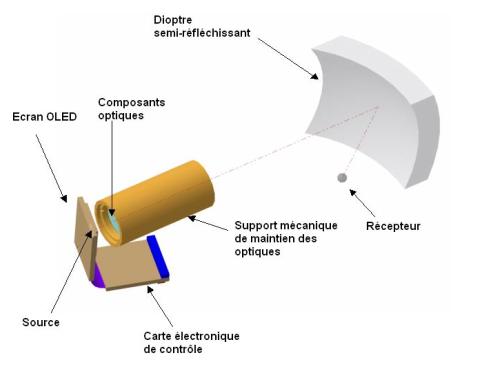Survey of head-up display technologies
Posted: May 5, 2012 Filed under: Uncategorized 1 CommentAs cool as my baseball cap headset looks, it is totally impractical in the real world. Not surprising, since it was built using off-the-shelf components.
But I was wondering, if I was working with people who actually knew what they were doing, what would be possible? In particular, what are the options for overlaying distant-focus images on a person’s field of view? A fresnel lens + half-mirrored reflector works, but the image quality isn’t great and it’s kind of bulky, so there must be better options.
The method used by Laster Technologies of France looks sensible. The focusing and reflection are handled by a single half-mirrored curved reflecting surface, presumably a parabolic segment. It’s cheap and easy to implement, and there’s not much that can go wrong. I’m not sure if it’s compact enough to be used in glasses, but it could certainly be used in a hat- or helmet-mounted configuration.
I wonder how clearly the contents of the display can be seen by others, given that the image is being projected forwards and not entirely reflected. With a baseball cap you could probably use the bill to block line-of-sight to the OLED, but it could be a problem with glasses.
The DigiLens by SBG Labs uses some pretty amazing technology. You really need to watch their video to see what’s going on, but here’s the gist of it: essentially, you can duplicate any lens arrangement using a hologram (which is far more compact than the lenses would be). Unfortunately, holograms only work with monochromatic light, so full-colour images haven’t been possible. The SBG solution is to use switchable holograms (which I didn’t know were possible). The red, green, and blue components of the image are cycled in rapid succession and relayed to the reflective element. The reflective element consists of a sandwich of three switchable holograms which cycle between reflective/transparent in sync with the images. If you cycle this fast enough, apparently your eyes see it as a full-colour image. I’m guessing you could use the same technology to generate full-colour 3D holograms, but that’s another topic.
All very impressive, but I have some concerns. First, it sounds expensive. Second, power consumption is going to be higher than Laster’s solution because the reflective element is constantly switching. Third, rapidly-switched RGB is supposed to look like full colour, but I’ll believe it when I see it. And finally, I wonder what sort of image quality you get when you use monochromatic RGB. I know that laser light looks weird, but that may be due to it being coherent rather than monochromatic.
The Vuzix STAR 1200 uses “patented quantum optic see-thru technology”, which means nothing to me. Does anyone know what technique they actually use?
Same problem with Lumus. They use a “patented LOE (Light-guide Optical Element) technology”, which might sound good from a marketing perspective, but it tells you nothing about how they actually work. Because it “shatters the perceived laws of conventional optics” I suspect they may be using SBG’s technology or a variant of it, but since I can’t be bothered doing a patent search, I don’t know for sure.
Are there any technologies I’ve missed?




if you make millions off this (and it hasn’t already been done) then throw me a bone…
your baseball cap HUD is pretty cool, and probably cheaper than my (as yet unimplemented) idea.
However, if you took a pair of cheap pico-style projectors, (I’m not sure of the minimum focal length on that kind of hardware, which might obliterate the usefulness of this,) turned down their brightness, and aimed one at each eye, they would achieve a similar effect without any reflectors.
You’re the real engineer, maybe you’ll have a better idea of feasibility.
I wandered here from your “adb for raspberry pi” thread on xda, by the way.
had no idea until today that you were the guy who wrote the most functional android x-server I’ve seen, but not too surprising.
nice work on all the projects I’ve looked at… the bus pirate is especially cool considering the price.